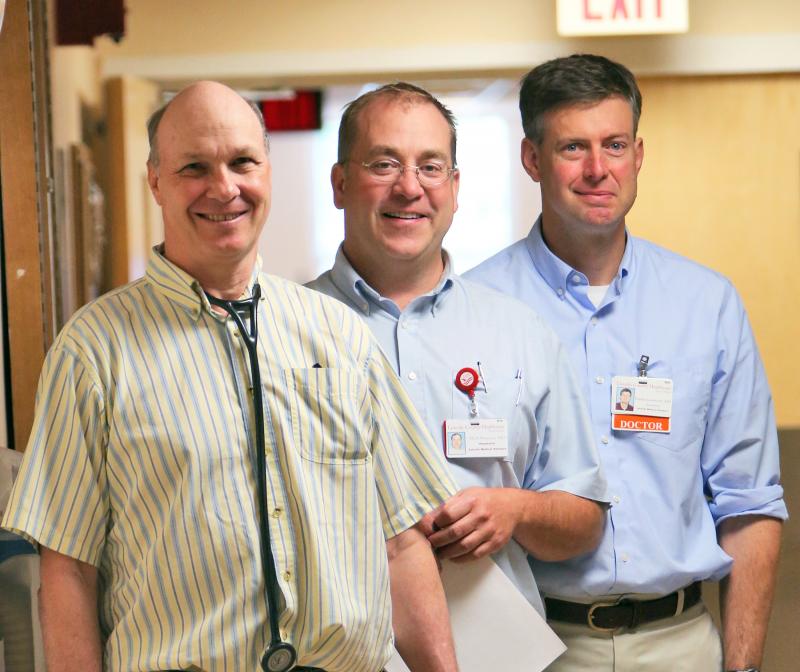A commitment to communication behind LincolnHealth’s quality scores
High quality scores at LincolnHealth, including a five-star rating from the U.S. Centers for Medicare & Medicaid Services, starts with a close relationship with the community, says Hospitalist Sean O’Donnell, MD.
The close connection between hospital staff and patients is part of the culture of LincolnHealth, said O’Donnell. It is an outgrowth of working in a small rural hospital where patients are often friends or neighbors.
It means doctors will wait for an extra set of lab tests to confirm a diagnosis. It can mean slowing down the discharge process to make sure there is a plan in place for the patient when they go home.
Most of all, it means communication, between nurses, doctors and case managers and with patients so the staff at the hospital doesn’t just understand the medical needs of a patient, they understand the obstacles the patient faces when they go home.
Understanding the obstacles to recovery that a patient faces when they go home is the critical first step in making sure patients have the support they need to recover at home. Despite serving an older population – Lincoln County is one of the oldest counties in Maine, itself the oldest state in the country - LincolnHealth has a readmission rate well below the state and national average.
Readmission rates – the percentage of patients who are readmitted to a hospital within 30 days of discharge – are a key quality indicator used by the U.S. Centers for Medicare and Medicaid Services (CMS).
Those low readmission rates and other quality indicators, including patient feedback, have helped LincolnHealth garner a series of quality awards, including the prestigious Leapfrog Award in three of the past four years and receiving Consumer Reports’ top safety rating of all hospitals nationwide in a May 2014 article.
According to the CMS Compare website, communication is a strong point at LincolnHealth.
LincolnHealth did much better than the national average when patients were asked if their nurses had always communicated well (87 percent) and whether their doctors had communicated well (87 percent) and whether they were given information about what to do when they left the hospital (89 percent). (These statistics are based on recent information on the Medicare.gov/hospitalcompare website.)
Stacy Oliver, RN, Case Management Supervisor at the Miles Campus of LincolnHealth, said case managers and other providers begin talking with patients about their return home as soon as possible after a patient is admitted.
They ask patients if they understand how to take their medications, whether they have somebody at home who can help them with meals or chores and whether they have transportation to the doctor’s office or the supermarket.
Those questions help case managers build a picture of the patient’s situation outside the hospital that they can use to decide what services that patient will need when they go home. Social circumstances and whether a patient has the money to buy new medications is particularly important, and those topics are often the most difficult for patients to discuss.
“Our patients tend to be pretty stoic,” said Oliver. “They are older Mainers. They take care of their own and they don’t like to ask for help.”
Daily interdisciplinary meetings that include hospitalists, nurses, case managers, speech therapists and other therapists, pharmacists and other clinicians, offer clinical team members a chance to share information about patients.
Each patient is discussed at those meetings and Oliver said having the input of many different clinicians who have contact with the same patients often helps to create a fuller, more accurate picture of the challenges the patient faces on their road to recovery.
“Maybe their teeth hurt and they need new dentures and that is why they don’t eat well,” said Oliver. In another case, a patient may not be able to read written instructions on how to take their medication.
All the information goes into the recovery plan, which may include a new set of dentures for one patient or instructions that include the use of illustrations for another.
The plan is boiled down to a simple concise message that is discussed with the patient, and then reinforced over and over by case managers, nurses and other clinicians who quiz the patient on aspects of the plan to make sure they know how to take their medications or when to use a walker to avoid falls.
“We constantly reinforce what they are taught because they will be more likely to be able to follow it, remember it and know how to do it,” said Oliver. “We really care and we want every patient to get the best care possible and to be as successful as possible at home.”
Event Date
Address
United States






















